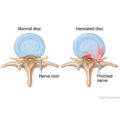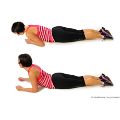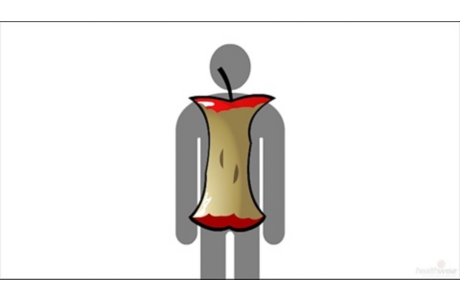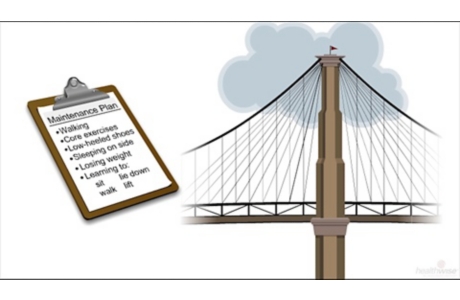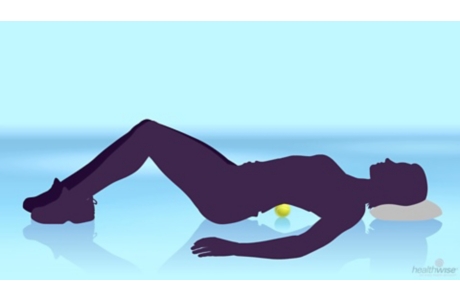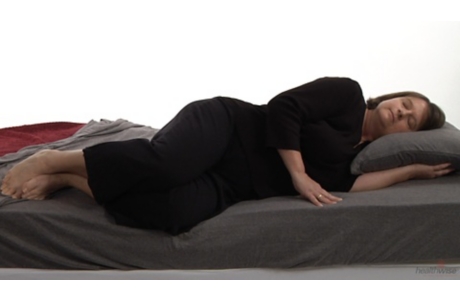Sciatica
Topic Overview
What is sciatica?
Sciatica is pain, tingling, or numbness produced by an irritation of the nerve roots that lead to the sciatic nerve. The sciatic nerve is formed by the nerve roots coming out of the spinal cord into the lower back. It goes down through the buttock, then its branches extend down the back of the leg to the ankle and foot.
What causes sciatica?
The most common cause of sciatica is a bulging or ruptured disc (herniated disc) in the spine pressing against the nerve roots that lead to the sciatic nerve. But sciatica also can be a symptom of other conditions that affect the spine, such as narrowing of the spinal canal (spinal stenosis), bone spurs (small, bony growths that form along joints) caused by arthritis, or nerve root compression (pinched nerve) caused by injury. In rare cases, sciatica can also be caused by conditions that do not involve the spine, such as tumors or pregnancy.
What are the symptoms?
Symptoms of sciatica include pain that begins in your back or buttock and moves down your leg and may move into your foot. Weakness, tingling, or numbness in the leg may also occur.
- Sitting, standing for a long time, and movements that cause the spine to flex (such as knee-to-chest exercises) may make symptoms worse.
- Walking, lying down, and movements that extend the spine (such as press-ups) may relieve symptoms.
How is sciatica diagnosed?
Sciatica is diagnosed with a medical history and physical exam. Sometimes X-rays and other tests such as magnetic resonance imaging (MRI) are done to help find the cause of the sciatica.
How is it treated?
In many cases, sciatica will improve and go away with time. Initial treatment usually focuses on medicines and exercises to relieve pain. You can help relieve pain by:
- Avoiding sitting (unless it is more comfortable than standing).
- Alternating lying down with short walks. Increase your walking distance as you are able to without pain.
- Using a heating pad on a low or medium setting for 15 to 20 minutes every 2 or 3 hours. Try a warm shower in place of one session with the heating pad. You can also buy single-use heat wraps that last up to 8 hours. You can also try an ice pack for 10 to 15 minutes every 2 to 3 hours. There is not strong evidence that either heat or ice will help, but you can try them to see if they help you.
Ask your doctor if you can take acetaminophen (Tylenol) or nonsteroidal anti-inflammatory drugs (NSAIDs) such as ibuprofen (Advil) or naproxen (Aleve). Be safe with medicines. Read and follow all instructions on the label
Additional treatment for sciatica depends on what is causing the nerve irritation. If your symptoms do not improve, your doctor may suggest physical therapy, injections of medicines such as steroids, stronger medicines such as muscles relaxants or opioids, or even surgery for severe cases.
Credits
Current as ofJune 26, 2019
Author: Healthwise Staff
Medical Review: William H. Blahd Jr. MD, FACEP – Emergency Medicine
E. Gregory Thompson MD – Internal Medicine
Adam Husney MD – Family Medicine
Kathleen Romito MD – Family Medicine
Kenneth J. Koval MD – Orthopedic Surgery, Orthopedic Trauma
References
Other Works Consulted
- American Academy of Orthopaedic Surgeons and American Academy of Pediatrics (2010). Lumbar herniated disc. In JF Sarwark, ed., Essentials of Musculoskeletal Care, 4th ed., pp. 952–956. Rosemont, IL: American Academy of Orthopaedic Surgeons.
- Atlas SJ, et al. (2005). Long-term outcomes of surgical and nonsurgical management of sciatica secondary to a lumbar disc herniation: 10-year results from the Maine Lumbar Spine Study. Spine, 30(8): 927–935.
- Ellenberg M, Ellenberg MJ (2015). Lumbar radiculopathy. In WR Frontera et al., eds., Essentials of Physical Medicine and Rehabilitation, 3rd ed., pp. 237–243. Philadelphia: Saunders.
Current as of: June 26, 2019
Author: Healthwise Staff
Medical Review:William H. Blahd Jr. MD, FACEP – Emergency Medicine & E. Gregory Thompson MD – Internal Medicine & Adam Husney MD – Family Medicine & Kathleen Romito MD – Family Medicine & Kenneth J. Koval MD – Orthopedic Surgery, Orthopedic Trauma
Topic Contents
This information does not replace the advice of a doctor. Healthwise, Incorporated, disclaims any warranty or liability for your use of this information. Your use of this information means that you agree to the Terms of Use. Learn how we develop our content.




